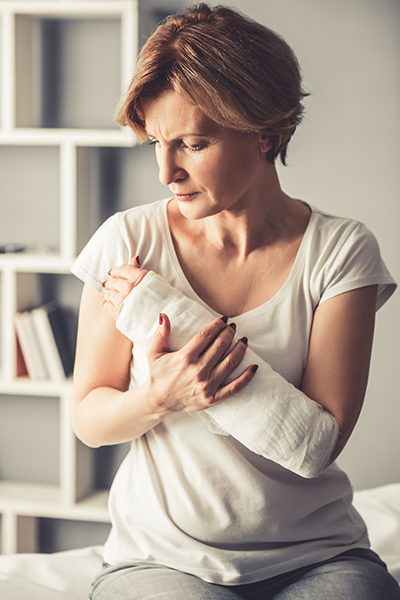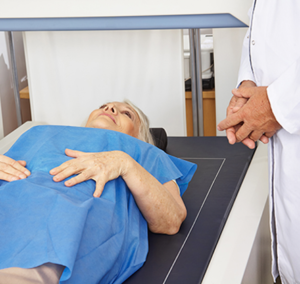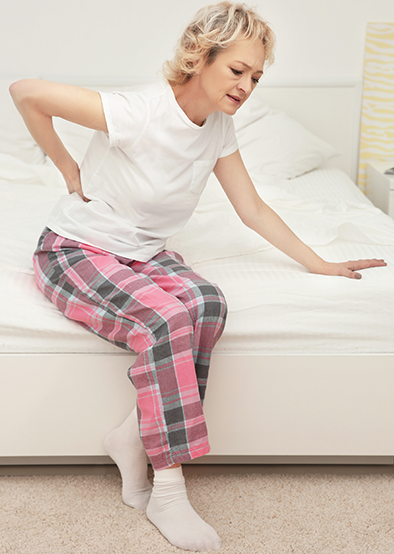This post is sponsored by Radius Health, Inc.
 A woman I know fell in her apartment from a standing height when she was in her late 50s, and suffered serious bone fractures in one arm that required surgery. She attributed the fall to the slippery floor, which certainly may have been the case. But osteoporosis was the reason her bones broke.
A woman I know fell in her apartment from a standing height when she was in her late 50s, and suffered serious bone fractures in one arm that required surgery. She attributed the fall to the slippery floor, which certainly may have been the case. But osteoporosis was the reason her bones broke.
Nearly 1 in 2 women over the age of 50 will suffer some sort of fracture as a result of osteoporosis. Osteoporosis-related fractures also cause more women 55 and older to be hospitalized each year in the US than breast cancer, heart attacks or strokes.
“It’s high time for women to educate themselves about the warning signs of osteoporosis,” said Meredith Vieira, the Emmy Award-winning talk show host, whose mother developed the disease and who is at risk of developing it herself. Joining forces with Radius Health, Meredith is making bone health a personal priority, and is on a mission for other postmenopausal women to be proactive and make it their priority, too.
 Meredith’s osteoporosis crusade
Meredith’s osteoporosis crusade
“When my mom developed what’s called a ‘dowager’s hump,’ sort of a hunched back, I never put two and two together to associate her spine problem with osteoporosis. I thought that getting shorter, and developing curvature of your spine, were part of the natural aging process,” Meredith said. After tripping on a step and breaking her pelvis, Meredith’s mother attributed it to being clumsy, “which is what so often happens with women when they have a fall,” Meredith explained.
“Osteoporosis was on my radar screen, but I didn’t think of it in terms of myself, until my doctor wanted me to have a bone density test after menopause, and it was determined I had osteopenia,” Meredith added. “I’m also at a higher risk of developing osteoporosis because of my family history, so I’ve been having a dialog with my doctor ever since. When Radius Health gave me the opportunity to educate other postmenopausal women, I jumped at the chance.”
“Back then, there were fewer treatments,” Meredith continued, “but now a variety of treatments are available, so it’s important that women inform themselves. Once you’ve had a fracture, there’s a greater likelihood that another fracture will follow, in people who have osteoporosis.”
 Osteoporosis 101
Osteoporosis 101
Osteoporosis is a disease that makes your bones weaker than they used to be, and more prone to fracture, whether from a fall, or even through normal activities that we do every single day, explained Dr. Susan V. Bukata, an orthopedic surgeon with UCLA Health. The disease affects nearly 8.2 million women in the US over the age of 50, and is thought to cause 2 million fragility fractures annually. (Note: A fragility fracture is defined as a low-impact fracture that is often the result of a fall from standing height or lower.)
“More than one in three people age 65 years or older falls each year. They might slip or miss a curb, and when someone has osteoporosis and falls from even one step or less and suffers a fracture, then the structure of their body isn’t strong enough,” Dr. Bukata.
The link between menopause and osteoporosis
“When a woman goes through menopause, and her estrogen production declines, she loses more bone, on average, in a short period of time than she is able to replace,” Dr. Bukata explained. “As the skeleton develops more perforations, it puts postmenopausal women at an increased risk of fracture.”
The bone density test
 “A bone density test can help tell us who has osteoporosis, or predict who will get it, based on bone mineral content alone. Osteoporosis is a silent disease, and until you fracture, the bone density test is a good way to identify patients at high risk for a fracture to occur. But, bone density is only half the equation, as I explained,” Dr. Bukata emphasized. “You can have only a reduced or low bone density, and you can still fracture.” Regardless of your bone density, if you are postmenopausal and have had a low-impact fracture, you have osteoporosis and are at a higher risk for a future fracture.
“A bone density test can help tell us who has osteoporosis, or predict who will get it, based on bone mineral content alone. Osteoporosis is a silent disease, and until you fracture, the bone density test is a good way to identify patients at high risk for a fracture to occur. But, bone density is only half the equation, as I explained,” Dr. Bukata emphasized. “You can have only a reduced or low bone density, and you can still fracture.” Regardless of your bone density, if you are postmenopausal and have had a low-impact fracture, you have osteoporosis and are at a higher risk for a future fracture.
The American Association of Clinical Endocrinologists/American College of Endocrinology guidelines recommend that a woman should have a bone density test at age 65 at a minimum, although women who are at increased risk for fracture should have the test earlier, advised Dr. Bukata.
 Besides the bone density test, doctors compute something called a FRAX score, which takes into account factors such as the medications you take, your family history, your age, and other diseases you may have, to determine your future risk of having a fracture.
Besides the bone density test, doctors compute something called a FRAX score, which takes into account factors such as the medications you take, your family history, your age, and other diseases you may have, to determine your future risk of having a fracture.
Testing aside, if you’re over 50 years old, and have a fragility fracture, you should definitely talk to your doctor because by definition you have osteoporosis, Dr. Bukata said. Following your initial fracture, you’re five times more likely to get another one. “The fracture tells us that your bones aren’t as strong as they should be to prevent future fractures.”
The roles of calcium and vitamin D in our bones
“Calcium is an important mineral in your skeleton because it helps maintain strong bones. And, you want to talk to your doctor to make sure that you are getting an adequate calcium intake,” according to Dr. Bukata.
 “If your body (blood) doesn’t have adequate calcium, it will steal from your skeleton! That’s why doctors focus on the calcium in your blood. Vitamin D, on the other hand, helps you to maintain calcium levels, and absorb calcium into your skeleton. So, a low level of vitamin D in your blood may indicate that you may not have enough calcium.”
“If your body (blood) doesn’t have adequate calcium, it will steal from your skeleton! That’s why doctors focus on the calcium in your blood. Vitamin D, on the other hand, helps you to maintain calcium levels, and absorb calcium into your skeleton. So, a low level of vitamin D in your blood may indicate that you may not have enough calcium.”
But taking calcium and vitamin D isn’t enough to prevent you from getting osteoporosis.
Osteoporosis treatments
Your body naturally removes old bone and replaces it with new bone, but after menopause, more bone is being removed than being replaced. “Many treatments can help strengthen the bones and maintain bone mass, so it’s important to have a conversation with your healthcare provider to determine which is best for you and your lifestyle,” Dr. Bukata said. Essentially, the treatments consist of either antiresorptive agents, which slow down the process of bone loss, maintaining the bone you have, or anabolics, which have been shown to help reduce the risk of fractures and build new bone.
“The FDA has recently approved TYMLOS™ (abaloparatide) injection from Radius Health, the first new anabolic agent for postmenopausal women with osteoporosis at high risk for fracture in the United States in almost 15 years,” Dr. Bukata reported.

The FDA’s approval of TYMLOS was based on the results of two clinical trials that showed “compared to placebo, TYMLOS decreased the chance of having a fracture of the spine and other bones in postmenopausal women with osteoporosis. There were consistent reductions in the risk of spinal and other types of fractures regardless of age, years since menopause, presence or absence of prior fracture, and bone mineral density (BMD) at baseline,” according to Radius Health. “TYMLOS also demonstrated consistent increases in BMD regardless of age, years since menopause, race, ethnicity, geographic region, presence or absence of prior fracture, and BMD at baseline.”
Weight bearing exercises and our bones
“Weight bearing exercise always is important because your body keeps the bones in as strong a configuration as possible in response to the mechanical force!” Dr. Bukata advised. “So, it’s important to walk, and be on your feet, and to use light weights to keep your arm bones strong as well–but it may not be the only thing required for bone health, especially if a patient is at high risk for a fracture or has already had an osteoporosis-related fracture.”
Acknowledging the disease
 “We’ve traditionally thought of osteoporosis as a natural part of aging,” Dr. Bukata explained. “Healthcare providers also push the disease down the list. Orthopedic surgeons fix the fracture; rehab experts get patients up and moving; internists worry about why their patients fell. Osteoporosis is one of the common diseases we see, but it slips through the cracks.”
“We’ve traditionally thought of osteoporosis as a natural part of aging,” Dr. Bukata explained. “Healthcare providers also push the disease down the list. Orthopedic surgeons fix the fracture; rehab experts get patients up and moving; internists worry about why their patients fell. Osteoporosis is one of the common diseases we see, but it slips through the cracks.”
Parting advice
“We’re our best advocates, so take the next step in educating yourself about keeping your bones healthy by going to www.bonenews.com,” Meredith Vieira said. “I’m excited about this next stage of my life, and I want to make sure I stay healthy. And don’t forget to advocate for your parents and your partners, too!”
—–
IMPORTANT SAFETY INFORMATION FOR TYMLOS
(ABALOPARATIDE)
What is the most important information I should know about TYMLOS?
TYMLOS may cause serious side effects including:
• Possible bone cancer (osteosarcoma). During animal drug testing, TYMLOS caused some rats to develop a bone cancer called osteosarcoma. It is not known if people who take TYMLOS will have a higher chance of getting osteosarcoma.
• Tell your healthcare provider right away if you have pain in your bones, pain in any areas of your body that does not go away, or any new or unusual lumps or swelling under your skin that is tender to touch.
Before you take TYMLOS, tell your healthcare provider about all of your medical conditions, including if you:
• have Paget’s disease of the bone or other bone disease, or will have trouble injecting yourself with the TYMLOS pen and do not have someone who can help you
• have or have had cancer in your bones, have or have had radiation therapy involving your bones, have or have had too much calcium in your blood, have or have had too much of an enzyme called alkaline phosphatase in your blood, have or have had an increase in your parathyroid hormone (hyperparathyroidism)
• are pregnant or plan to become pregnant because TYMLOS is not for pregnant women, or are breastfeeding or plan to breastfeed. It is not known if TYMLOS passes into your breast milk. You and your healthcare provider should decide if you will take TYMLOS or breastfeed. You should not do both.
Tell your healthcare provider about all the medicines you take, including prescription and over-the-counter medicines, vitamins, and herbal supplements.
What are the possible side effects of TYMLOS?
TYMLOS can cause serious side effects including:
• Decrease in blood pressure when you change positions. Some people may feel dizzy, have a faster heartbeat, or feel lightheaded soon after the TYMLOS injection is given. These symptoms generally go away within a few hours. Take your injections of TYMLOS in a place where you can sit or lie down right away if you get these symptoms. If your symptoms get worse or do not go away, stop taking TYMLOS and call your healthcare provider.
• Increased blood calcium (hypercalcemia). TYMLOS can cause some people to have a higher blood calcium level than normal. Your healthcare provider may check your blood calcium before you start and during your treatment with TYMLOS. Tell your healthcare provider if you have nausea, vomiting, constipation, low energy, or muscle weakness. These may be signs there is too much calcium in your blood.
• Increased urine calcium (hypercalciuria). TYMLOS can cause some people to have higher levels of calcium in their urine than normal. Increased calcium may also cause you to develop kidney stones (urolithiasis) in your kidneys, bladder or urinary tract. Tell your healthcare provider right away if you get any symptoms of kidney stones which may include pain in your lower back or lower stomach area, pain when you urinate, or blood in your urine.
The most common side effects of TYMLOS include:
• dizziness, nausea, headache, fast heartbeat, feeling very tired (fatigue), upper stomach pain, vertigo
These are not all the possible side effects of TYMLOS. Call your doctor for medical advice about side effects. You may report side effects to FDA at 1-800-FDA-1088.
• If you take more TYMLOS than prescribed you may experience symptoms such as muscle weakness, low energy, headache, nausea, dizziness (especially when getting up after sitting for a while) and a faster heartbeat. Stop taking TYMLOS and call your healthcare provider right away.
What is TYMLOS?
TYMLOS is a prescription medicine used to:
• decrease the chance of having a fracture of the spine and other bones in postmenopausal women with thinning and weakening bones (osteoporosis).
• treat osteoporosis in postmenopausal women who are at high risk for bone fracture.
It is not known if TYMLOS is safe and effective for children 18 years and younger.
It is not recommended that people use TYMLOS for more than 2 years during their lifetime.
TYMLOS should not be used in children and young adults whose bones are still growing.
Please click here for the full Prescribing Information and Medication Guide for TYMLOS, including Boxed Warning.
© 2017 Radius Health, Inc. All rights reserved. 08/17. TYM-US-00333
